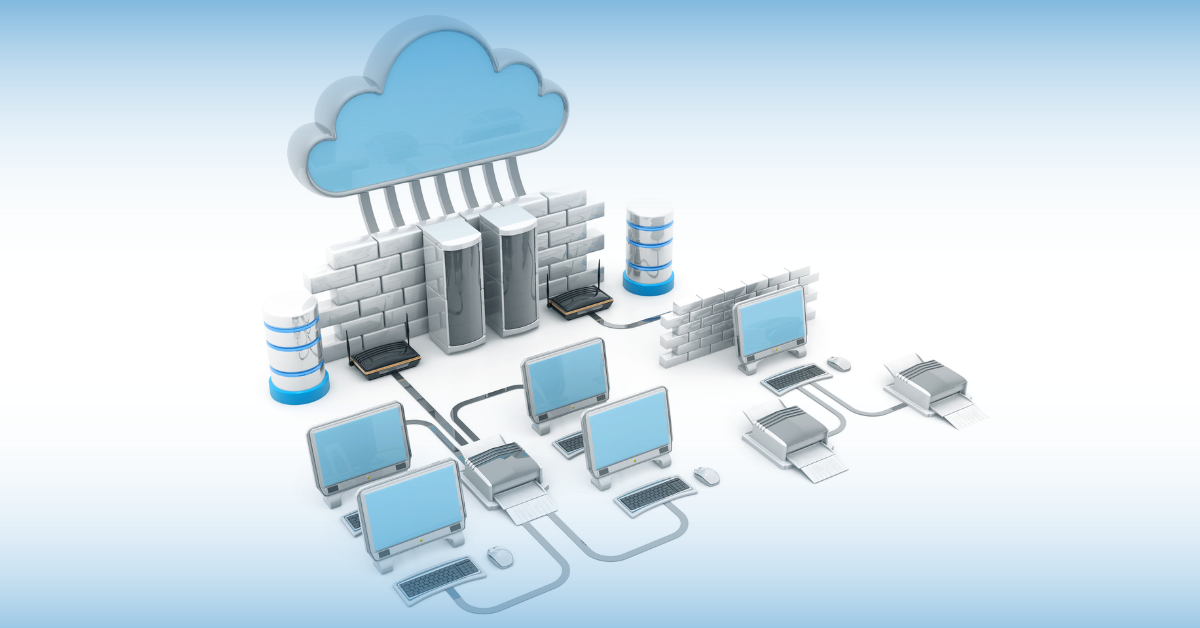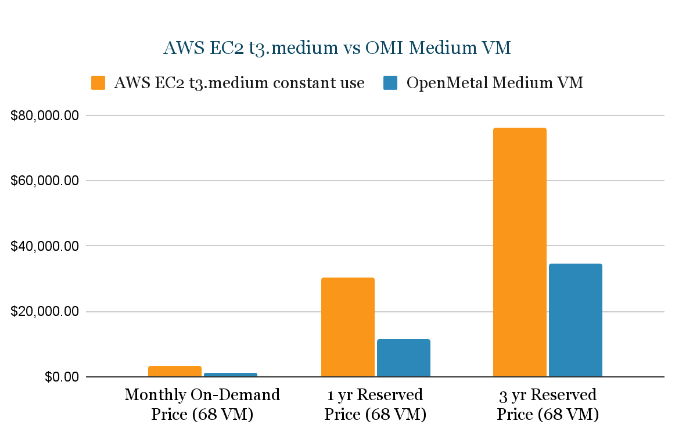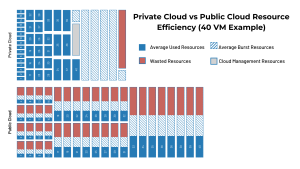
In this blog post I’m going to explore the advantages of using OpenStack to create a cloud environment and attempt to quantify those benefits for your organization. The 2022 OpenStack user survey report showed that OpenStack is more alive than ever with over 40 Million cores in production.
This does not come as a surprise to the open source community, considering the annual public cloud spend is in the hundreds of billions. For small and medium sized organizations, high cloud spend is not something they can afford. And as time has passed and OpenStack has evolved, the barriers to getting started on OpenStack are lower and the savings make it hard to ignore.
The Advantages of Using an OpenStack Cloud
Savings
One of the biggest perks of choosing to use open source technology is the savings. OpenStack’s software is freely available for public use so you can download it and build your own cloud and OpenStack providers can do the same. If it costs cloud providers significantly less to build their clouds, those savings should trickle down to the consumers who may not have the resources to build their own cloud. Unfortunately I don’t have the time to break down in this post all the price comparisons of various cloud products across the multitude of cloud providers but it is imperative that I provide a point of comparison to help you conceptualize the savings that open source provides.
Let’s look at AWS’ EC2 t3.medium and compare it to OpenMetal’s Medium VM. I picked these products because they have the same amount of memory, same vCPU and I was able to find pricing from both AWS and OpenMetal for data centers in Virginia. So on paper they are very similar products and can be used for a fair comparison.
| Details | AWS EC2 t3.medium constant use | OpenMetal Medium VM | Difference | |
|---|---|---|---|---|
| Memory | 4 GB | 4 GB | n/a | |
| vCPU | 2 | 2 | n/a | |
| Monthly On-Demand Price | $32.19 | $19.06 | $13.13 | |
| 1 yr Reserved Pricing | $235 | $228.24 | $33.76 |
Now at this point it may be easy to say hey, that’s not a fair comparison, because you cannot buy a single VM from OpenMetal, OpenMetal provides users with an entire OpenStack cloud. So let’s take this comparison further. For this comparison, I used OpenMetal’s Standard V2 cloud on which you can spin up roughly 68 VMs of this size without any additional cost or fees. This OpenMetal cloud also comes with 12TB of Egress so when I requested the price estimate with AWS price calculator I made sure to include 12TB of Egress.
| Details | AWS EC2 t3.medium constant use | OpenMetal Medium VM | Difference |
|---|---|---|---|
| Memory | 4GB | 4GB | N/A |
vCPU | 2 | 2 | N/A |
Includes Egress | 12TB/month | 12 TB/month | N/A |
Monthly On-Demand Price (68 VM) | $3,284.80 | $1,353.60 | $1,931.20 |
| 1 yr Reserved Pricing (68 VM) | $30,184.56 | 11,532.72 | $18,651.84 |
| 3 yr Reserved Pricing(68 VM) | $76,078.8 | $34,598.16 | $41,480.64 |

Now that’s more than 50% savings. What would your organization do if your cloud bill was reduced by more than 50%?
AWS was the first major cloud provider and set the standard for allowing access to clouds with a low entry point threshold, and while it is cheaper to begin your cloud journey on public clouds, once you reach a certain level of growth, switching to open source options like OpenMetal On-Demand Private clouds provide you with greater savings. The waste in cloud spend quickly adds up which is why it is important for organizations to be aware of their cost tipping point. At what point does it become economical for your business to switch platforms and providers?
Control
When you have control at the cloud level the efficiency and opportunities for optimizations are well worth learning the platform. To list a few of the advantages you have when you control your cloud, you can:
- Set resource quotas for every project, providing users the flexibility to expand the resources in use for their environment while obeying hard limits determined by the cloud administrator.
- Create switches and routers easily allowing the cloud administrator to create segregated private networks projects to keep them secure. Your Private Cloud is a superset of public cloud’s Virtual Private Clouds.
- Allocate resources that your containers can tap into when needed for bursting, this keeps you from incurring additional costs during peaks. Because administrators have full control over what workloads are on the cloud, they can make sure to diversify the containers so they are not all bursting at the same time.
- Spin up and down as many instances as the cloud’s hardware can accommodate without any additional costs.
- Designate resources for each VM spun up. With a private cloud, the administrator has control over setting the flavors of VMs, and if a VM starts to show signs of resource contention, you can resize the VM with a favor allocating more resources.
- Have exclusive access to the hardware, so you won’t experience lag from unknown noisy neighbors who may have the same peak times as you.
Community
One beautiful thing about OpenStack is the amazing community that the Open Infrastructure Foundation has built. 110,000 members strong in over 187 countries is not just for bragging rights. In addition to working together to continually improve and upgrade the various projects, there are mentorship programs in place to help new users learn how to use OpenStack. There are two levels of mentoring: Outreachy Mentoring (an intense internship-type experience over three months for groups who are underrepresented in the open source community) and Upstream Training (a two-day class for beginners in the community).
The Women of OpenStack also have their own mentoring initiatives: Cohort Mentoring (long term program) and Speed Mentoring (sessions are open to everyone, not just women). Getting started on OpenStack is no longer that confusing journey of stumbling blindly in a dark closet trying to figure out how things work by yourself. There’s programs and documentation in place to help you.
In addition to the documentation available on OpenStack’s website, there is pretty thorough documentation on the website of many OpenStack providers such as OpenMetal. On the OpenMetal website, you can find product manuals, goal oriented tutorials, Kubernetes specific documentation and other OpenStack Tutorials.
Automation
It’s no secret that OpenStack is difficult to setup, but that really isn’t an OpenStack specific problem, if you were to setup your own AWS it would probably be more difficult (because its code isn’t freely available in addition to all the regular complications you encounter while setting up a cloud). This is why it is more desirable to begin your OpenStack journey as a resource user. OpenMetal allows you to deploy an entire production ready private OpenStack cloud in 45 seconds.
Now that we’ve covered how to easily get started on OpenStack, let’s make the day to day administering of your cloud easier. On OpenStack, you can use automation tools such as Terraform, Kolla Ansible and Heat to build, update and delete cloud infrastructure safely, efficiently, and in a repeatable manner
If you are looking for guides on how to set up and configure various automation tools in your OpenStack cloud, you can check out these guides on: TerraformKolla Ansible, and Heat.
Vendor-Neutral
Recognizing how quickly your cloud bill can grow as your organization continues to put workloads on the cloud, it’s important to be able to move your workloads to another provider if pricing becomes an impediment to your organization’s growth. No one wants to be stuck with a cloud bill that’s rapidly depleting their profit, especially in a world where technology is constantly evolving and cheaper options may become available.
Using OpenStack makes it easy to switch between OpenStack providers or to an OpenStack On Prem solution when your organization and engineering team has grown to a point where you can do so. Some OpenStack providers like OpenMetal have bare metal services and they will build your custom OpenStack cloud in your own data center.
In 2023 we’re no longer getting stuck with unpredictable high cloud bills, terrible/non-existent customer service, or a wasteful cloud. We’re talking control of our bill and our infrastructure.
Kubernetes Integration
Kubernetes is another open source software used for container orchestration systems that you can use for automation software deployment, scaling and management. While Kubernetes was originally developed by Google, OpenStack has evolved to allow Kubernetes integration. In fact, Kubernetes is currently deployed on 85% of OpenStack deployments. With the vast majority of OpenStack users running Kubernetes in their deployments, the open source community has a lot of engineers making sure that Kubernetes is running smoothly and can easily run – and this is also the case on our OpenStack. In fact, OpenMetal’s customer moved over Kubernetes workloads from AWS and realized 50% savings.
Speed and Reliability
The open source community is working hard to keep OpenStack up to date and compatible with the evolving tech world. Because there are so many organizations with a vested interest in using OpenStack it is in their best interest that OpenStack remains at the cutting edge of the industry. And with 110,000+ members on the job, integration with other popular open source software and updates to debug and perfect OpenStack software in itself happens really quickly. For customers that want a bit more distance from the tech we recommend checking out the managed private cloud.
To conclude, there are many reasons why organizations are turning to OpenStack and with so many major organizations looking to cut infrastructure costs, we can expect to see more growth in OpenStack deployments in the years to come.
More on the OpenMetal Blog…

Private Cloud Fundamental Advantage vs Public Cloud
In this blog:
- Why does private cloud have such a significant advantage in cost and performance?
- Private Cloud vs Public Cloud Resource Efficiency for the Buyer!

What Are The Projects That Make Up OpenStack?
In this blog:
- What Are The Projects That Make Up OpenStack?
- What Are The Core OpenStack Projects?
- What Are Other OpenStack Projects

OpenStack vs VMware: Cost Considerations
In this blog:
- Acquisition of VMware
- The OpenStack vs VMware Alternative
- The World is Beginning to Run on OpenStack
- Costs You Need to Understand
Test Drive
For eligible organizations, individuals, and Open Source Partners, Private Cloud Cores are free to trial. Apply today to qualify.
Subscribe
Join our community! Subscribe to our newsletter to get the latest company news, product releases, updates from partners, and more.


































